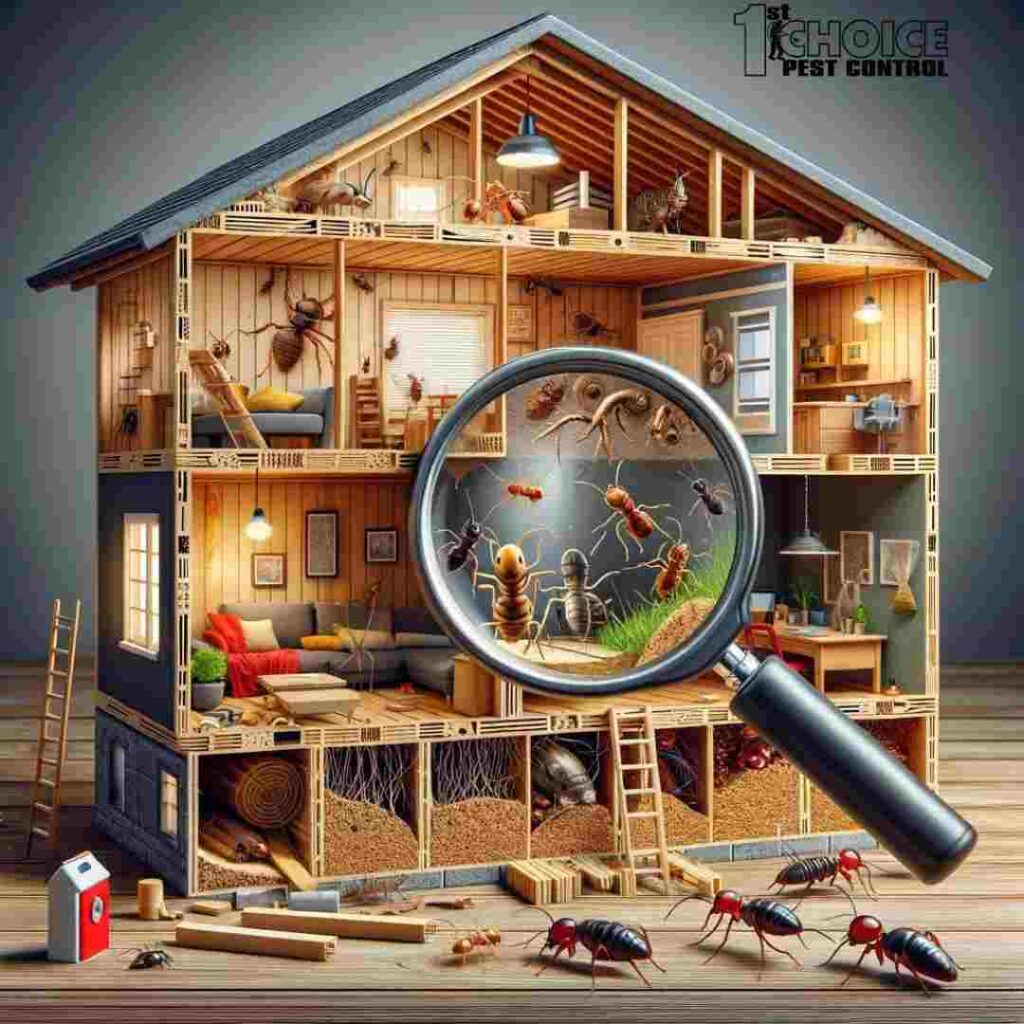Discovering Early Signs of a Pest Infestation: Unmasking the Secret Invaders
Every year, countless homeowners are caught off guard by unwelcome visitors that aren’t just a nuisance but can pose serious threats to both health and property. Imagine this: hidden beneath the quiet façade of your home, an army of secret invaders could be plotting their next move. These aren’t the characters from a suspense thriller but common household pests that, if left unchecked, can lead to significant problems.
Detecting a pest infestation early can be the difference between a simple extermination and a full-blown invasion that requires professional intervention. Unfortunately, these invaders are stealthy, often giving no obvious sign of their presence until the infestation has reached alarming levels. However, with the right knowledge and vigilance, you can spot these early warning signs and take action to protect your home.
In this blog post, we’ll guide you through identifying the most common culprits, including termites, rodents, ants, and cockroaches, and provide you with essential tips on how to notice and interpret the early signs of their presence. Understanding these signs is crucial in preventing the extensive damage and health risks associated with pest infestations. Let’s dive into the world of pest detection and ensure your home remains a safe haven, free from the clutches of these secret invaders.
Understanding the Enemy: Common Household Pests
Before we delve into the early warning signs of pest infestations, it’s crucial to know who these invaders might be. Several culprits can make their way into our homes, each with unique habits and indicators. Let’s introduce you to some of the most unwelcome guests:
- Termites: Often dubbed the “silent destroyers,” termites can chew through wood, flooring, and even wallpaper undetected. They thrive in moist, hidden environments, making them hard to spot until significant damage has occurred.
- Rodents: Mice and rats seek warmth and food, making your home the perfect haven, especially during cooler months. They can cause damage by chewing through materials, contaminate food sources, and spread diseases.
- Ants: While ants are less likely to cause as much structural damage as termites, certain species can be destructive. Ants are often attracted by food remnants and can enter homes through the smallest openings.
- Cockroaches: These resilient pests are not only a health hazard but also a sign of unsanitary conditions. They can spread bacteria and pathogens by contaminating food and surfaces they come into contact with.
Understanding these pests is the first step in guarding your home against them. Each pest has specific behaviors and preferences for habitat, which can influence the signs you should look for when identifying a potential infestation. By familiarizing yourself with these common household pests, you’re better equipped to recognize the early warnings they leave behind.
In the following sections, we’ll explore why catching these signs early can be pivotal in maintaining the safety and integrity of your home. Stay tuned as we uncover the subtle hints that could indicate the presence of these secret invaders.
Why Early Detection Matters
Understanding the havoc that pests can wreak in our homes underscores the value of early detection. It’s not merely about inconvenience; pests can pose significant risks to our health, well-being, and the structural integrity of our living spaces. Here’s why catching them early is more than just a preventative measure—it’s a crucial intervention.
- Health Risks: Many pests are carriers of diseases or can cause health-related issues. For example, rodents can spread hantavirus, salmonella, and other serious diseases, while cockroach allergens can trigger asthma attacks, especially in children. Early detection can help mitigate these health risks.
- Property Damage: Termites and rodents can cause considerable damage to your home, gnawing through wood, electrical wiring, and plumbing, potentially leading to expensive repairs. Early identification of such pests can prevent structural damage and save homeowners significant repair costs.
- Cost of Extermination: Addressing a small, manageable pest problem is invariably less expensive than eradicating a full-blown infestation. Early detection can thus lead to substantial cost savings in extermination fees and associated repairs.
- Peace of Mind: Knowing your home is free from pests or that you’ve caught an issue early can provide significant peace of mind. The stress of dealing with an extensive infestation can affect your quality of life, making early detection a crucial step in maintaining a happy, healthy home environment.
The consequences of overlooking the signs of an infestation are too significant to ignore. With the stakes involving health, safety, and financial well-being, understanding and acting upon the early signs of pests in your home becomes a critical aspect of home maintenance. Next, we’ll explore the signs of a pest infestation, providing you with the knowledge needed to identify potential problems before they escalate.
Signs of a Pest Infestation
Early detection of pests hinges on recognizing the subtle signs that indicate their presence. Here are some common indicators for each type of pest:
- Termites: Look for mud tubes on exterior walls, wood that sounds hollow when tapped, and discarded wings near doors or windowsills.
- Rodents: Keep an eye out for droppings, gnaw marks on furniture or wiring, and nests made of shredded paper or other materials in secluded areas.
- Ants: Watch for trails of ants, especially leading to food sources, and small mounds of earth around properties indicating nests.
- Cockroaches: Be alert to droppings that resemble coffee grounds or black pepper, a musty odor, and egg casings in dark, secluded areas.
Visual clues are often the first indication of a pest problem. Regularly inspecting your home for these signs can help catch an infestation in its early stages.
Prevention Tips
Preventing pest invasions is more effective and less costly than dealing with an established infestation. Implement these strategies to keep pests at bay:
- Seal Entry Points: Conduct a thorough inspection of your home’s exterior. Look for gaps around windows, doors, utility pipes, and cables. Use caulk, steel wool, or appropriate sealants to close these openings. Pay special attention to the foundation and attic vents, as these are common entry points.
- Eliminate Moisture: Many pests are attracted to moisture for drinking or as a habitat. Regularly inspect your home for leaking pipes, clogged drains, and any other sources of water accumulation. Ensure your gutters and downspouts are clear and directing water away from your home’s foundation.
- Keep It Clean: A clean home is your first defense against pests. Wipe down counters and sweep floors to remove crumbs and spills. Store food, especially grains and pet food, in airtight containers. Regularly take out the trash and use cans with sealing lids to deter pests.
- Declutter: Clutter provides hiding spots and nesting materials for pests. By minimizing clutter, you can reduce these opportunities. Focus on areas like garages, basements, and attics, where clutter tends to accumulate. Consider adopting minimalist habits to keep spaces open and uninviting to pests.
- Landscaping: Proper landscaping can deter pests. Keep the lawn mowed, bushes trimmed, and trees pruned so branches don’t touch your home’s exterior. Consider using gravel or rock strips between your lawn and home foundation, which can be less appealing to pests than mulch or soil.
What to Do If You Spot Signs of Pests
Discovering signs of a pest infestation can be alarming, but it’s important to act swiftly and calmly:
- Isolate the Area: If you find evidence of pests in a specific area, try to limit their ability to spread. This might mean sealing off rooms or placing affected items in plastic bags until you can address the issue.
- Avoid DIY Solutions for Major Infestations: Some pests, like bed bugs or termites, require professional treatment to fully eradicate. Over-the-counter solutions might only offer temporary relief and could even exacerbate the problem. Research effective methods for minor pests but recognize when to call in experts.
- Contact a Professional: A reputable pest control professional can offer identification, treatment, and prevention strategies tailored to your specific situation. Look for licensed, well-reviewed services in your area. Don’t hesitate to ask about their methods and products to ensure they’re safe for your family and pets.
- Follow-Up: After professional treatment, follow any advice given to prevent a recurrence. This might include regular inspections or modifications to your home or habits. Establishing a routine check can help catch new issues early.
Conclusion
The secret to managing pest invasions lies not in the battle but in the vigilance to prevent a war. By understanding common household pests, recognizing the early signs of an infestation, and taking preventive measures, you can protect your home and health from these unwanted invaders. If you do spot signs of pests, remember that early intervention by professionals can save you not just in terms of potential damage and health risks but also financially.
For peace of mind and a pest-free home, consider scheduling regular inspections with 1st Choice Pest Control. Remember, the key to effective pest management is not just reaction, but proactive prevention. Let us help you keep your home safe and secure from the secret invaders.



 Service Request
Service Request